MARBLE VILLA PROJECTS

MARBLE LIVING ROOM
The use of marble in the living room enriches the ambiance of the space by offering both elegance and functionality. Marble design provides a luxurious and sophisticated appearance, while its durable structure ensures high performance in long-term use. The various color, texture, and pattern options of marble harmonize with the style of the living room, creating an elegant and modern look in the interior.
What are the advantages of using marble in the living room, and how should it be used?
1. Luxurious and Elegant Atmosphere
– Marble, especially in white, grey and beige tones, offers an elegant atmosphere in living rooms. Its light-reflecting polished surface makes the room appear more spacious and bright.
– Natural marble veining makes each piece unique and adds a sophisticated touch to the space.
2. Flooring Application
– Marble Flooring: Marble is an highly popular choice for living room floors. It is both durable and visually impressive, making it ideal for spacious living rooms and luxurious interiors. It offers aesthetic appeal with its variety of patterns and colors, while also being long-lasting and robust.
– Variety of Patterns and Colors: The natural veining and color transitions of marble create unique patterns. Light tones such as white, grey and brown provide a modern and minimalist style, while darker tones create a classic and elegant atmosphere.
3. Marble Wall Cladding
– Using marble on living room walls adds an elegant touch to the space. I can especially be applied as feature walls. Marble wall panels enhance the sophistication of the room by creating focal points.
– Marble Pattern: The veining and color of marble add a unique look to the walls. Particularly on large, prominent wall surfaces, it creates a visually appealing effect.
– Surface Treatment Options: Marble surfaces can be processed as polished, honed or matte. This creates varying effects in the space depending on the room’s lighting conditions.
4. Marble Tables and Other Furniture
– Marble is also used on furniture surfaces. It is a stylish option, espceially for tables, dining tables or consoles. A marble table can be a standout piece in the living room with its elegant form and polished surface.
– Adding metal or wooden legs to marble tables or coffee tables can create a modern design.
5. Marble Fireplace Surrounds and Mantels
– Marble is an ideal material for fireplace surrounds. The warmth of natural stone complements the elegant structure of the fireplace and creates a focal point. The shine and texture of marble enhance the visual impact of the fireplace.
– Additionally, using marble for the fireplace mantel harmonizes with both classic and modern designs.
6. Marble Accessories
– Decorative Items: Marble can also be used in living room accessories such as vases, lamps, floor lamps, and small decorative objects. The cool texture of marble provides an elegant touch to modern interiors.
– Large Vases or Sculptures: Large marble decorative pieces can serve as focal points in the living room.
7. Marble TV Units and Shelving Systems
– Using marble in TV units or shelving systems adds a refined detail to the living room. Marble’s sturdy structure makes it an ideal material for such furniture.
– A minimal base under a marble TV unit can create a stylish space.
8. Marble Lamps and Lighting Elements
– Marble can also be used for stylish lighting elements and lamps. Marble-based lamps complement the elegance of the living room. Additionally, the effect of marble can be enhanced with various lighting plays.
– Lighting in the Space: The natural shine of marble surfaces, especially with proper lighting, creates a striking visual atmosphere in the space.
9. Durability of Marble
– Marble is a durable and long-lasting material, making it an ideal choice for high-traffic areas like living rooms. Its ease of maintenance helps marble preserve its aesthetic value for many years.
– Ease of Cleaning: Marble surfaces do not easily retain dirt and are very easy to clean. With a few simple cleaning steps, they can always look clean and polished.
10. Climate Compatibility of Marble
– Marble is resistant to temperature and humidity changes. Therefore, it can be used in living rooms for many years without being affected by climate variations. Additionally, its natural cooling feature creates a refreshing atmosphere during the summer months.
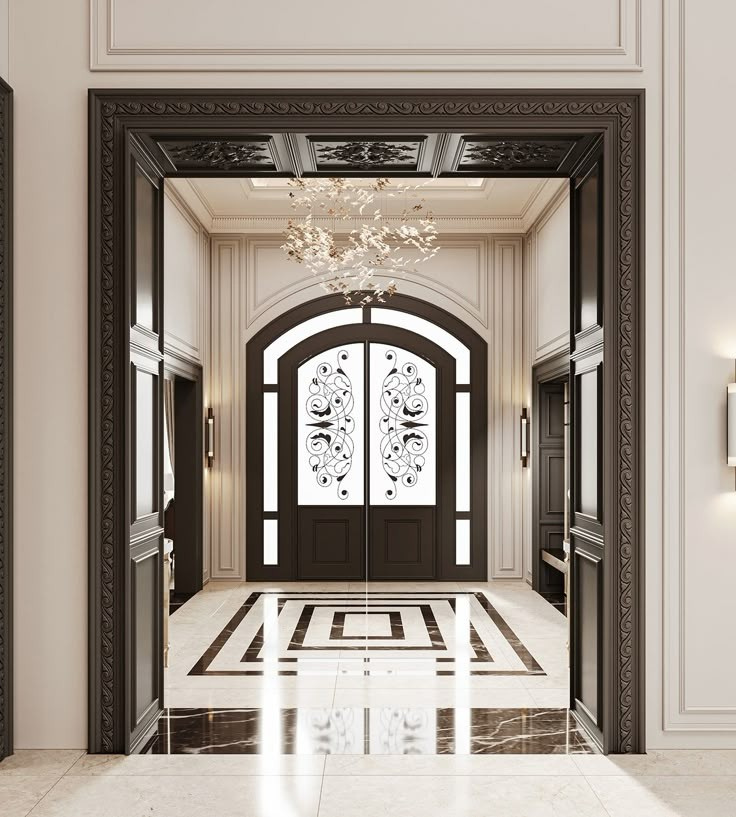
MARBLE ENTRYWAY
The use of marble in hallways and entryways can ensure these spaces appear visually elegant, refined, and spacious. These areas are typically crucial for creating the first impression of a home, and therefore, employing a luxurious material like marble adds a sophisticated touch to the overall design of the residence.
How to Use Marble in Hallways and Entryways?
1.Marble Flooring
– Marble Floors: Marble flooring in hallways and entryways immediately draws attention and adds an elegant atmosphere to the overall design of the home. The natural veining of marble creates unique and distinctive patterns for each tile. While neutral colors such as white, gray and beige are commonly preferred, various other color tones of marble can also be used.
– Patterned Marble Floors: The veined patterns of marble can create a striking accent in the entryway. Such patterns, particularly in spacious entryways, can enhance elegance and make the space appear more refined.
– Marble Mosaic Patterns: Mosaic flooring made from different colored marbles can add a unique sophistication to the entryway. These can be used effectively in both modern and classic design styles.
2. Wall Cladding
– Marble Wall Panels: Using marble cladding for walls in the entryway provides a luxurious touch to the space. The natural texture and patterns of marble create a visually captivating aesthetic on the walls.
– Partial Wall Cladding: Instead of full marble cladding, using marble on the lower portion or a specific section of the wall can be a stylish option. Marble used as a focal point on a single wall complements a minimalist style.
3. Marble Details in Entryway Furniture
– Marble Consoles and Side Tables: Incorporating marble surfaces on console tables or side tables in the hallway or entryway can add an elegant and sophisticated ambiance. Marble surfaces are particularly effective in simple and minimalist designs.
– Marble Shelves: Using marble for wall shelves in the entryway provides both a stylish appearance and functional space. Decorative objects or books placed on these shelves highlight the natural beauty of the marble.
4. Marble Door Frames and Other Details
– Marble Door Frames: Using marble frames around the entrance door in the hallway can create an aesthetically pleasing detail. The durability and elegant appearance of marble provide a robust and beautiful feature that can be used for many years.
– Marble Door Thresholds: Marble thresholds at the base of doors, especially in high-traffic areas, offer a practical solution while also serving as a visually appealing complementary detail.
5. Marble in Corners and Transition Areas
– Marble Corner Details: Corners in hallways or entryways can be enhanced with marble detailing. Applying marble to corner transitions adds an elegant touch to the overall design of the space.
– Marble Strips in Transition Areas: If the entryway connects to other rooms, using marble strips along the floor or walls in these transition areas can stylishly link different spaces together.
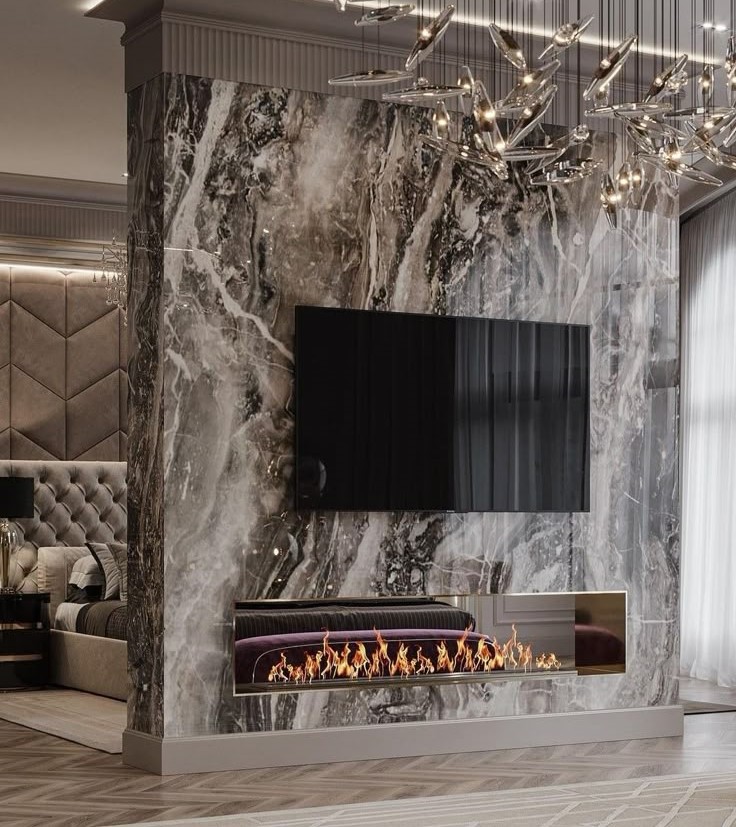
MARBLE TV UNIT
Marble TV units are an excellent way to create a modern and stylish atmosphere. Marble adds an elegant touch to the TV unit in terms of both aesthetics and functionality, while also offering durability and longevity.
Advantages and Details of Using Marble in TV Units
1. Aesthetics and Elegance
– Refined and Luxurious Appearance: The natural veining and color transitions of marble lend a sophisticated ambiance to the TV unit. White, gray, cream, or black marble options are ideal for modern, minimalist, or classic design styles.
– Light Reflection: Marble reflects light on its surface, making the room appear more spacious and bright. Using polished marble on a TV unit enriches the room’s atmosphere.
2. Durability and Longevity
– Robust Structure: Marble is a strong and durable material. Using marble in a TV unit provides a long-lasting solution, particularly for surfaces subject to heavy use. It is also resistant to temperature change and impacts.
– Temperature Regulation: Marble’s ability to balance temperature changes ensures it does not negatively affect the operation of electronic devices on the TV unit. Additionally, marble retains less heat as it warms, contributing to energy efficiency.
3. Easy Surface Maintenance
-Easy Cleaning: Marble is an easily cleanable material. Marble surfaces on TV units can be quickly cleared of fingerprints, dust, and stains, helping maintain a consistently fresh and clean appearance.
– Water and Stain Resistance: Marble is non-absorbent and highly effective against stains, ensuring it remains clean for extended periods.
4. Variety of Design Options
– Diverse Marble Types and Color Options: Marble adapts to any interior style with its wide range of colors and patterns. White marble offers an elegant and modern look, while darker tones create a stylish and luxurious feel. Patterned marble adds a unique and eye-catching design to the TV unit.
– Plain or Veined Marble: The natural veining of marble creates a unique pattern for each piece, adding individual character to the TV unit while harmonizing with both modern and traditional interiors.
5. Functional Use
– Aesthetic and Practical Balance: Marble is not only visually appealing but also functionally effective in TV units. Its heavy and sturdy structure ensures the TV unit remains stable and secure, providing a flat surface for various electronic devices.
– Heat Conductivity: When combined with the cool surface of marble, electronic devices on the TV unit maintain a balanced temperature even during extended use, contributing to their longevity.
6. Corner and Connection Details
– Seamless and Stylish Connections: Marble can be preciselly cut and shaped, ensuring aesthetically pleasing connections and joints. Both straight and rounded coroner options allow for modern designs.
– Classic and Modern Designs: Depending on the TV unit’s design, marble edges can be straight, rounded or beveled allowing customization to suit the interior style.
7. Environmentally Friendly and Sustainable
– Natural and Sustainable Material: As a naturally occurring material, marble is environmentally friendly. Its long lifespan allows for reuse and repurposing, contributing to more sustainable interior design.
8. Combination with Other Materials
– Harmony with Metal or Wood Details: Marble pairs perfectly with materials like metal or wood. Combining marble with wooden shelves or metal frames on a TV unit creates a stylish and modern appearance.
Using marble in a TV unit is not only an aesthetic choice but also a practical one, enhancing durability and functionality. With its elegant appearance, diverse color and pattern options, marble holds a significant place in the world of design. Suitable for both modern and classic interiors, this material adds a sophisticated touch to the TV unit while ensuring long-term use.
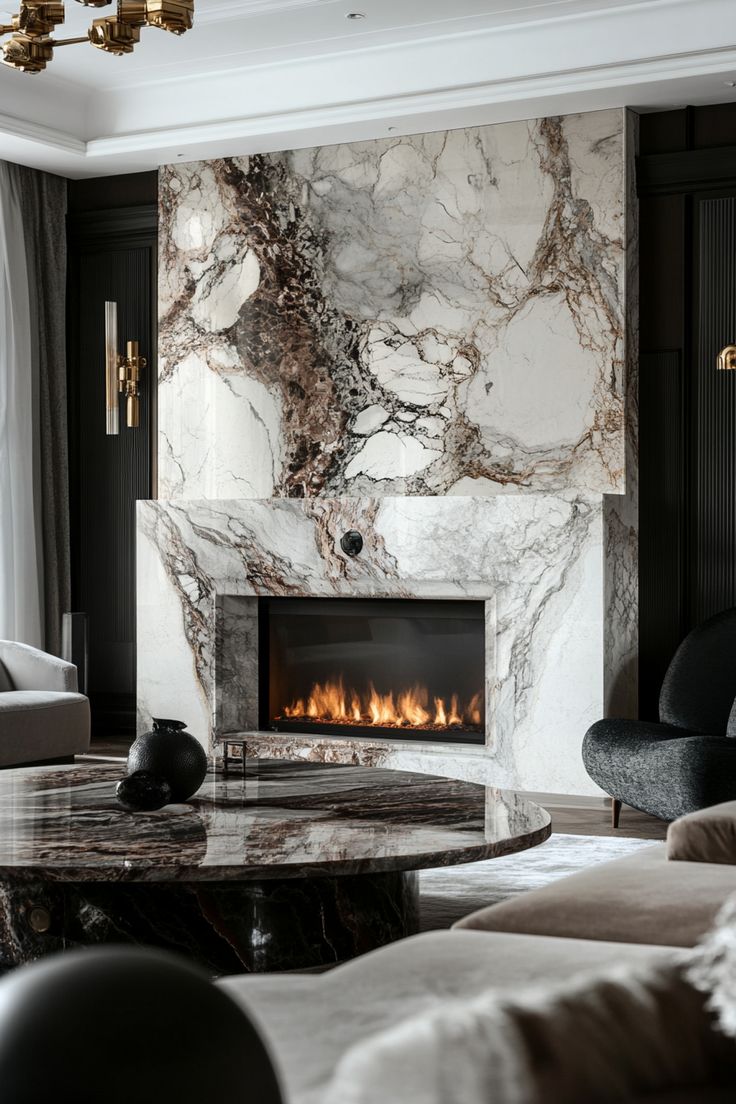
MARBLE FIREPLACE
The use of marble in fireplaces ensures a luxurious and elegant interior design. Marble is an ideal choice for fireplaces, offering both aesthetic appeal and functional benefits. Incorporating marble around the fireplace adds sophistication to the space while providing a durable and long-lasting structure.
Advantages and Recommendations for Using Marble in Fireplaces
1. Aesthetics and Elegance
– Refined and Luxurious Appearance: The natural veining and color transitions of marble create a unique aesthetic around the fireplace. White, cream, and gray tones are particularly compatible with modern and classic interiors.
– Light Reflection: The glossy surface of marble reflects light beautifully, making the room appear brighter and more spacious. Marble around the fireplace enriches the room’s atmosphere.
2. Fireplace Mantel and Surround
– Fireplace Mantel: Marble is a commonly preferred material for fireplace mantels. Applied around the fireplace, marble adds a decorative feature while being durable and long-lasting.
– Custom Design: Marble can be shaped using various cutting techniques. Marble fireplace mantels designed for modern or classic styles enhance the elegance of the space.
3. Durability
– Fire Resistance: Ateşe Dayanıklı: Mermer, yüksek sıcaklıklara karşı dayanıklıdır. Bu özelliği, şömine gibi sıcaklık değişimlerinin fazla olduğu alanlarda mermerin ideal bir malzeme olmasını sağlar. Mermer, ısının yayılmasını engellemez, aksine sıcaklığı eşit şekilde dağıtır.
– Longevity: Marble is a durable and long-lasting material. Marble cladding around the fireplace resists wear over time and retains its visual appeal for many years.
4. Variety of Color and Pattern Options
– Marble adapts to any interior style with its diverse color and pattern options. White and gray tones are ideal for modern designs, while darker marbles create a classic and luxurious atmosphere.
– Patterned Marble: The unique veining of marble makes each panel distinctive, creating a striking focal point around the fireplace.
5. Temperature and Balance
– Cool/Heat Distribution: Marble helps maintain the room’s temperature balance. It prevents rapid heat dissipation, contributing to a longer-lasting warm environment.
– Balancing Property: The cool nature of marble helps balance the heat of the fireplace, providing a refreshing effect, especially during summer months.
6. Easy Maintenance of Marble
– Easy to Clean: Marble surfaces are easy to clean and maintain. Especially around fireplaces, where ash or soot may require frequent cleaning, marble’s ease of maintenance is a significant advantage.
– Stain and Dirt Resistance: Marble is non-absorbent and resistant to stains, making it suitable for comfortable use around the fireplace.
7. Corner and Connection Details
– Seamless and Stylish Connections: As a material that can be precisely cut, marble provides an aesthetically pleasing appearance even at corner transitions. Its natural veining ensures a stylish continuity at joints and corners.
– Custom Patterned Transitions: Marble offers flexibility in shaping. Corner transitions around the fireplace can be rounded, straight, or beveled, allowing for varied aesthetic outcomes.
Using marble around fireplaces creates an elegant, stylish, and functional atmosphere. The durable structure, aesthetic variety, and easy maintenance of marble make it an ideal material for fireplace designs. With its natural veining and unique color transitions, marble enables the creation of a visually stunning fireplace area in every home.
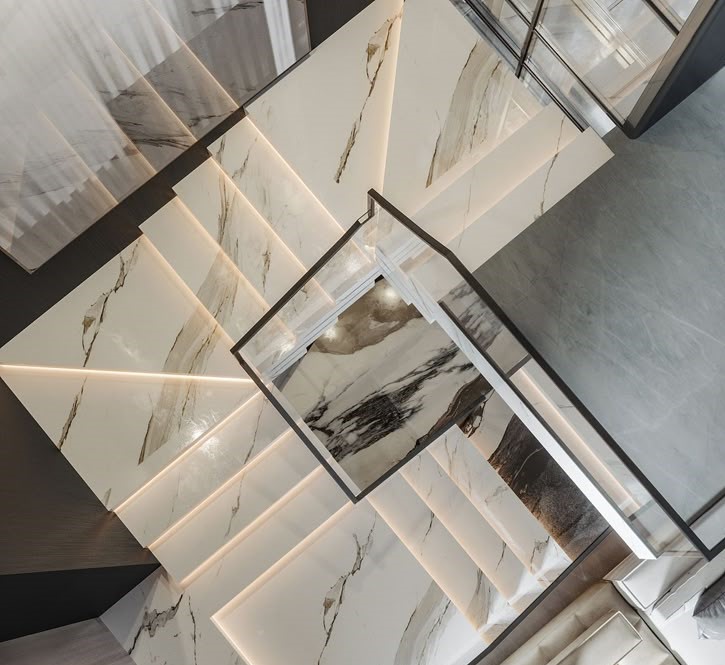
MARBLE STAIRCASE
The use of marble in staircases adds elegance from an aesthetic perspective and offers functional advantages. Marble, with its natural beauty, refined appearance, and durability, creates a luxurious atmosphere while being a long-lasting and low-maintenance material.
Advantages and Considerations of Using Marble in Villa Interior Staircases:
1. Elegant and Luxurious Ambiance
– Marble, as a luxurious and refined material, adds a sophisticated touch to staircases in villa interiors. Its various color tones and patterns can complement any interior style.
– Light-colored marbles, such as white, beige, or gray, make the interior appear spacious and bright, harmonizing with both modern and classic styles.
– Natural marble veining imparts a unique and aesthetic appearance to each step.
2. Durability and Longevity
– Marble is a highly durable and long-lasting material. In interior staircases, which may experience wear due to heavy use, marble is minimally affected by such impacts.
– Marble’s durability ensures staircases remain clean and elegant over time. It is resistant to impacts and can be used for many years without losing its aesthetic qualities.
3. Ease of Maintenance
– Marble is an easy-to-clean and maintain material. Dust, dirt, and stains may accumulate on staircases over time, but marble’s smooth surface makes it difficult for such dirt to adhere.
– With regular cleaning, marble staircases always appear shiny and elegant.
4. Diverse Color and Pattern Variations
– Natural marble veining and color transitions make each step unique, adding a distinctive appearance to marble staircases. Different color tones and patterns bring a personalized touch to villa interior designs.
– Subtle veining in white marble or dramatic patterns in darker marbles enhance the visual impact of staircases.
5. Variety of Surface Finishes
– Marble can be used in staircases with various surface finishes. Glossy, matte, honed, or polished options alter the appearance of marble, aligning with the overall ambiance of the space.
– Glossy surfaces reflect light, making the area appear larger and more spacious, while matte or honed surfaces provide a more natural look.
6. Non-Slip Feature
The non-slip properties of marble staircases are an important safety factor. Polished marble surfaces may be slippery, so non-slip marble options can be preferred.
– Additionally, non-slip strips can be added to the edges of steps, or marble can be processed to create non-slip surfaces.
7. Design Compatibility with Interiors
– Marble staircases can harmonize with modern, classic, or industrial interior styles. Minimalist and simple marbles can be chosen for modern designs, while detailed veining or rich color tones suit classic styles.
– Marble steps can also be combined with other materials like metal, wood, or glass. For example, marble steps can be paired with wooden railings or complemented by modern glass railings.
8. Aesthetic and Visual Impact
– Marble staircases can serve as a visual focal point in villa interiors. Marble usage in areas like the base or top of the staircase, where emphasis is desired, enhances visual impact.
– Marble interacts with light, adding brightness and depth to the space. In wide staircases, natural light can further highlight marble’s beauty.
The use of marble in staircases creates an elegant atmosphere combined with sophistication and durability. With its refined veining, aesthetic texture, and durable properties, marble offers an ideal option for staircase design. Additionally, marble’s visual impact, longevity, and ease of maintenance make it a perfect material for interior staircases.
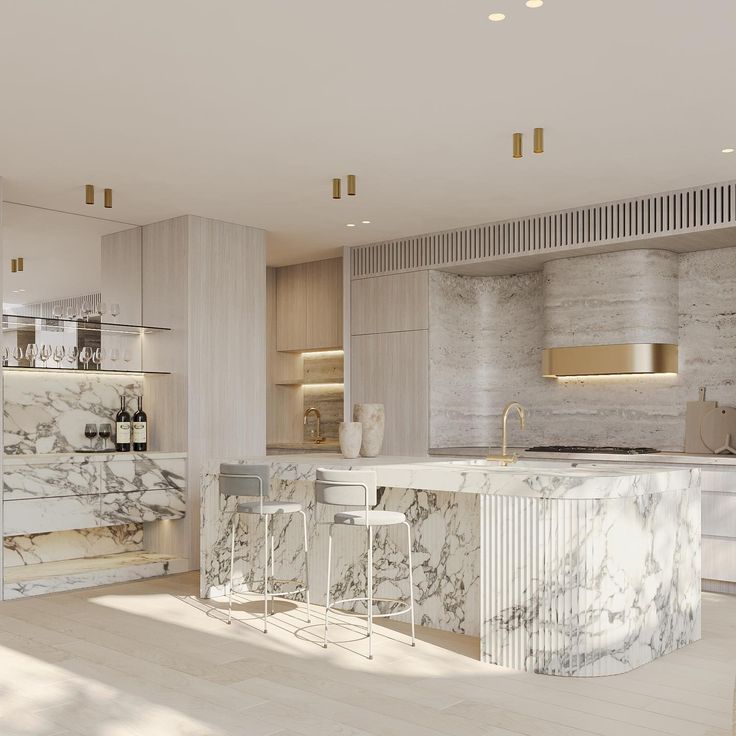
MARBLE KITCHEN
Kitchens are one of the most frequently used and occupied spaces in a home. Therefore, kitchen design is of great importance in terms of both aesthetics and functionality. Marble, with its elegant appearance, durability, and longevity, is among the preferred materials for kitchens.
Advantages and Considerations of Using Marble in Villa Interior Staircases:
1. Aesthetics and Elegance
– Luxurious and Refined Appearance: Marble adds a luxurious and elegant atmosphere to kitchens. Polished surfaces, in particular, reflect light, illuminating the kitchen and making it appear more spacious.
– Unique Patterns: Marble’s distinctive veining and patterns lend a unique character to every kitchen. The natural veining ensures each piece is one-of-a-kind, allowing for personalized customization with various colors and patterns.
– Color Options: Offering a wide range of colors such as white, gray, black, cream, green, and brown, marble complements any kitchen decor. Light tones are ideal for modern kitchens, while darker tones suit classic and luxurious designs.
2. Durability and Longevity
– Heat and Temperature Resistance: Marble is highly resistant to heat. Placing hot pots or pans directly on its surface does not cause damage, making it suitable for intensive kitchen use.
– Scratch and Stain Resistance: Marble’s natural structure ensures durability for long-term use. However, caution is needed on cutting surfaces, as acidic substances (e.g., lemon or vinegar) may cause staining. Proper protection and maintenance are required.
3. Use in Work Surfaces
– Countertops and Islands: Marble is an excellent choice for kitchen countertops and kitchen islands. It is both aesthetically pleasing and functional, suitable for long-term use. Its smooth surface is ideal for cutting and food preparation.
– Unique Designs: Marble can be shaped with various cutting techniques for kitchen islands, allowing for distinctive designs enriched with different colors and patterns. Techniques like “bookmatch” or “mosaic” can create unique visuals.
4. Easy Cleaning and Maintenance
– Surface Cleaning Only: Marble’s smooth and even surface is easy to clean. Regular cleaning with water and soap preserves kitchen marble surfaces for a long time. However, acidic substances must be avoided.
– Hard Surface: Marble is known for its ease of cleaning and maintenance. When properly cleaned, stains do not form, ensuring long-term usability. However, water or liquids should not be left on the surface for extended periods.
5. Environmental Compatibility and Naturalness
– Natural Material: As a naturally occurring material, marble is environmentally friendly. Natural stones used in kitchen decor offer a healthy and sustainable option.
– Natural Aesthetics: Marble’s elegant veining and color transitions bring nature’s aesthetic touch to your kitchen, adding warmth and authenticity.
6. Various Application Areas
– Kitchen Countertops: Marble is particularly popular for kitchen countertops. It is durable, stylish, and practical, offering resistance to hot pots and pans while providing elegance during kitchen tasks.
– Backsplash Applications: Marble is commonly used in kitchen backsplashes, the protective wall area. Its easy cleaning and aesthetic appearance stylishly adorn kitchen walls.
– Sink and Basin Areas: Marble is also used in sink and basin areas, providing an aesthetically pleasing touch and durable, long-term use.
7. Caution with High Temperatures and Acidic Substances
– Acidic Substances Caution: Marble is sensitive to acidic substances. Lemon, vinegar, or tomatoes can cause stains on marble surfaces, so these should be avoided or quickly wiped away.
-Heat Resistance: Marble is heat-resistant, but hot pots should not be placed directly on the surface. Using a heat-resistant pad can prevent potential issues.
8. Evolving Aesthetics Over Time
– Patina Effect: Marble may develop a natural patina over time, which can enhance its aesthetic structure. This natural aging process adds character to your kitchen.
Marble use in kitchens offers numerous advantages in terms of aesthetics, durability, and functionality. Its natural and elegant appearance adds sophistication to kitchens while its longevity provides a practical solution. Marble is an aesthetic and functional choice for countertops, flooring, walls, and more. Thus, incorporating marble in kitchen decor ensures a stylish and lasting result..
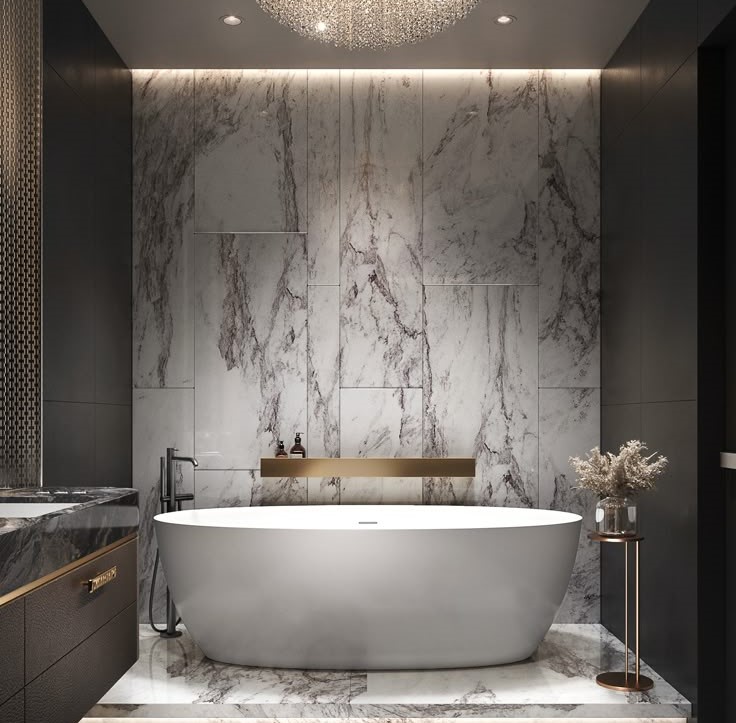
MARBLE BATHROOM
Bathrooms are personal care and relaxation spaces in the home. Therefore, bathroom design must be both aesthetically pleasing and functional. Marble is a commonly preferred natural material in bathroom decor. With its numerous advantages, such as aesthetics, durability, and ease of maintenance, marble is an ideal choice for adding an elegant and luxurious ambiance to bathrooms.
Advantages and Considerations of Using Marble in Bathrooms:
1. Aesthetic and Elegant Appearance
– Luxury and Sophistication: Marble’s unique veining and natural texture add an elegant and luxurious atmosphere to bathrooms. Marble surfaces bring a sophisticated touch to the space.
– Rich Color Options: With colors like white, gray, black, green, and cream, marbles can be selected to match bathroom decor. White and gray tones are ideal for modern bathrooms, while black and darker colors provide a classic and luxurious look.
– Natural Patterns: Marble’s distinctive patterns offer a unique and individualized appearance for each piece, adding originality to the bathroom.
2. Durability and Longevity
-Water Resistance: Marble is water-resistant, making it a perfect option for bathroom use. However, waterproofing may be necessary to prevent water from lingering on the surface.
– Heat Resistance: Marble is resistant to heat, making it ideal for hot showers or baths, as hot water does not damage bathroom surfaces.
– Long-Lasting Use: Known for its long-term durability, marble can be used for years with proper maintenance.
3. Marble Use in Bathroom Flooring
– Floor Coverings: Marble is frequently used for bathroom floors. Its smooth and even surface facilitates easy cleaning. Marble floors elevate bathroom design with their elegance and durability.
– Non-Slip Surface Options: Non-slip marbles should be preferred for bathroom floors, especially in shower areas, to enhance safety and reduce the risk of slipping.
4. Marble in Wall Cladding
– Bathroom Walls: Marble is an excellent choice for bathroom walls, particularly in shower areas or around sinks, where its water-resistant properties make it ideal.
– Bathroom Panels and Backsplash: Marble panels or backsplash applications around bathroom sinks are a popular choice for adding elegance to bathroom decor, while benefiting from marble’s water resistance.
5. Marble Use in Bathroom Countertops
– Sinks and Countertop Areas: Marble is commonly used for bathroom countertops and sinks. Its natural texture offers an elegant appearance, and its water-resistant properties ensure long-lasting use.
– Elegant Sinks: Marble sinks provide a luxurious option for bathroom design. Round, cornered, or modern designs can create varied styles, adding a sophisticated ambiance to the bathroom.
6. Other Uses of Marble in Bathrooms
– Marble Bathroom Accessories: Marble can be used not only for floors and walls but also for bathroom accessories. Marble soap dishes, toothbrush holders, bottles, and trays complement the bathroom’s elegance.
– Bathroom Shelves: Marble shelves are both aesthetic and functional, offering water-resistant storage for bathroom products in an organized manner.
7. Easy Cleaning and Maintenance
Low Maintenance Needs: Properly cleaned marble surfaces resist water stains and dirt. Cleaning with soap and water is sufficient. However, contact with acidic substances should be avoided, as they may cause staining.
– Protective Applications: Surface protective sprays and water-repellent products can extend marble’s lifespan, preventing staining and preserving its shine.
8. Caution with High Temperatures and Acidic Substances
– Acidic Substances Caution: Marble is sensitive to acidic substances like lemon, vinegar, soap, alcohol, and other acidic products, which can damage its surface. Contact with such substances should be avoided.
– Heat Resistance: Marble is heat-resistant, but direct contact with hot water may leave marks on the surface. Using a protective pad provides heat resistance.
9. Health Benefits of Marble in Bathrooms
– Natural and Healthy Material: As a natural stone, marble contains no chemicals, preventing the release of harmful substances in humid bathroom environments, making it highly safe for health.
Timeless Elegance: Marble’s natural and timeless beauty keeps bathroom decor stylish for years without needing changes. With proper care and cleaning, its lifespan is extensive.
Marble is a perfect choice for bathrooms, being both aesthetically elegant and functionally durable. Its high resistance to heat and water offers a long-lasting and stylish solution. Marble’s unique patterns transform the bathroom’s ambiance, creating a luxurious and refined atmosphere. Its natural texture perfectly complements bathroom decor.

MARBLE BEDROOM
Using marble details in the bedroom is an excellent way to add both elegance and sophistication. As a natural stone, marble brings a refined touch and modern ambiance to the room’s design.
Areas and Details for Using Marble in the Bedroom:
1. Headboard and Wall Cladding
– Marble Headboard: The headboard is one of the most striking elements in a bedroom. A marble headboard creates a focal point in the room. Various colors and patterns of marble can be selected to match the overall style of the space.
– Marble Wall Cladding: Adding marble cladding to the headboard area or one wall in the bedroom can impart a luxurious ambiance. The texture and patterns of marble make the room’s atmosphere elegant and refined.
2. Bed Surround and Nightstands
– Marble Bed Surround: Marble can also be used around the bed. Incorporating marble details around the bed frame enhances the overall elegance of the room.
– Marble Nightstands: Marble-clad nightstands offer a modern and sophisticated appearance. The natural patterns of marble can seamlessly integrate with other furniture in the room. Nightstands are typically chosen to complement the headboard.
3. Bedroom Floor Covering
– Marble Floors: Marble is a durable and aesthetically pleasing option for bedroom flooring. With various color options, it creates an elegant and stylish floor, making the room appear more spacious and fostering a bright environment.
Using marble in the bedroom adds an elegant touch and creates a spacious, luxurious atmosphere. The durability and aesthetic qualities of marble enable the creation of a functional and stylish design in the bedroom. Marble use in headboards, floors, nightstands, and accessories can be carefully designed to complete the room’s elegance.
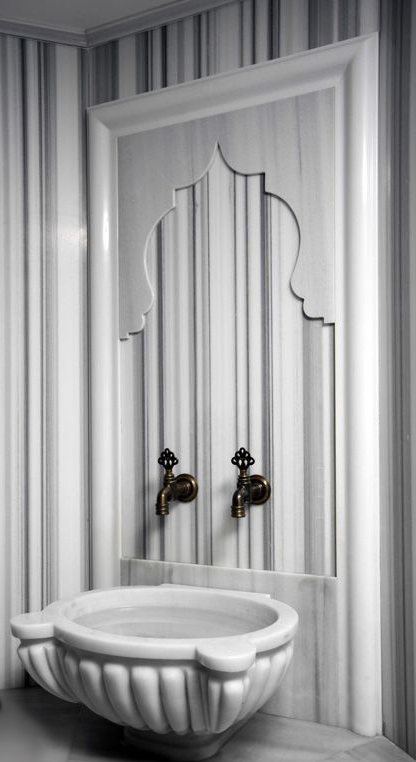
TURKISH BATH
The Turkish bath, an integral part of traditional Turkish culture, is frequently incorporated into luxury villas as a space for relaxation and wellness. Marble is an indispensable material in Turkish baths, playing a significant role in their design due to its aesthetic and functional advantages.
Reasons and Advantages of Using Marble in Turkish Baths in Villas:
1. Aesthetic and Traditional Appearance
– Elegant and Stylish Atmosphere: Marble imparts an elegant and traditional ambiance to the interior of the Turkish bath. Using marble on high walls and floors creates a luxurious and distinctive atmosphere, with its various colors and patterns harmonizing with the overall design.
– Natural Patterns: The natural veining of marble makes each piece unique, adding visual richness to the bath while enhancing its traditional character. White, green, cream, yellow, and gray-toned marbles create a warm and natural environment.
2. Heat and Humidity Resistance
– High Temperature and Humidity: Turkish baths typically have high temperatures and humidity levels. Marble is a durable material under these conditions, remaining unaffected by heat and moisture, ensuring long-lasting aesthetic integrity.
– Heat Distribution: Marble evenly distributes heat, complementing the hot stones in Turkish baths to provide warmth to the body and enhance the traditional bath experience. Its ability to stabilize heat increases the bath’s relaxing effect.
3. Health Benefits and Hygiene
– Ideal for Health: As a natural stone, marble is free from chemicals, creating a clean and healthy environment in the bath. Its resistance to water, humidity, and bacteria ensures a hygienic surface.
– Antibacterial Properties: Marble’s natural structure prevents water accumulation, inhibiting bacterial and mold growth in humid environments, thus providing a healthy setting in Turkish baths.
4. Marble Use in Floors and Walls
– Floor Coverings: Marble use in Turkish bath floors offers both aesthetic and functional solutions. Non-slip marble options ensure safe usage, while marble’s cool texture provides a soothing contrast to the bath’s warm atmosphere.
– Wall Cladding: Marble is commonly used on Turkish bath walls, enhancing the visual appeal of the interior. Its heat-balancing properties prevent moisture accumulation on walls when combined with steam.
5. Marble Details and Accessories in the Bath
– Marble Benches and Seating Areas: Turkish baths often include seating and massage areas. Marble benches and surfaces create a traditional bath atmosphere, with marble’s cool texture offering a refreshing sensation in the warm environment.
– Bath Kurnas and Sinks: Marble is preferred for kurnas (water basins) and sinks in Turkish baths. Its water-resistant structure enhances functionality, while traditional motifs carved into sinks and kurnas create elegant visual details.
6. Marble Use in Corners and Joints
– Aesthetic Joint Details: Marble use in corner joints of Turkish baths provides elegant transitions. Its natural texture and clean lines ensure aesthetic continuity at corners and joints.
– Corner Profiles and Carvings: Specially crafted marble in wall corners and joints reinforces the traditional Turkish bath style.
7. Marble Use in Exterior Design
– Exterior Facade Design: When constructing Turkish baths in villas, marble can also be used on the exterior facade. Marble’s grandeur complements the bath’s luxurious and traditional ambiance when viewed from outside. It is ideal for both interior and exterior use, as it withstands both hot and cold weather conditions.
8. Timeless Aesthetic
Durability and Beauty: Marble is a durable material that does not lose its aesthetic qualities over time. Its color does not fade, and its structure remains intact, ensuring the Turkish bath maintains its quality for years. Marble’s natural and traditional texture becomes even more beautiful with time.
9. Budget and Investment
– High Investment Value: Although marble is generally an expensive material, its long-term durability and aesthetic contribution make it an excellent investment. Marble details in Turkish baths are not only aesthetically pleasing but also functionally superior.
Marble use in Turkish baths in villas offers numerous aesthetic and functional advantages. Marble’s natural beauty, durability, and hygienic properties make it an ideal material choice for Turkish bath design. Reinforcing the elegant and luxurious ambiance of the bath, marble is one of the most essential components of the traditional Turkish bath atmosphere.
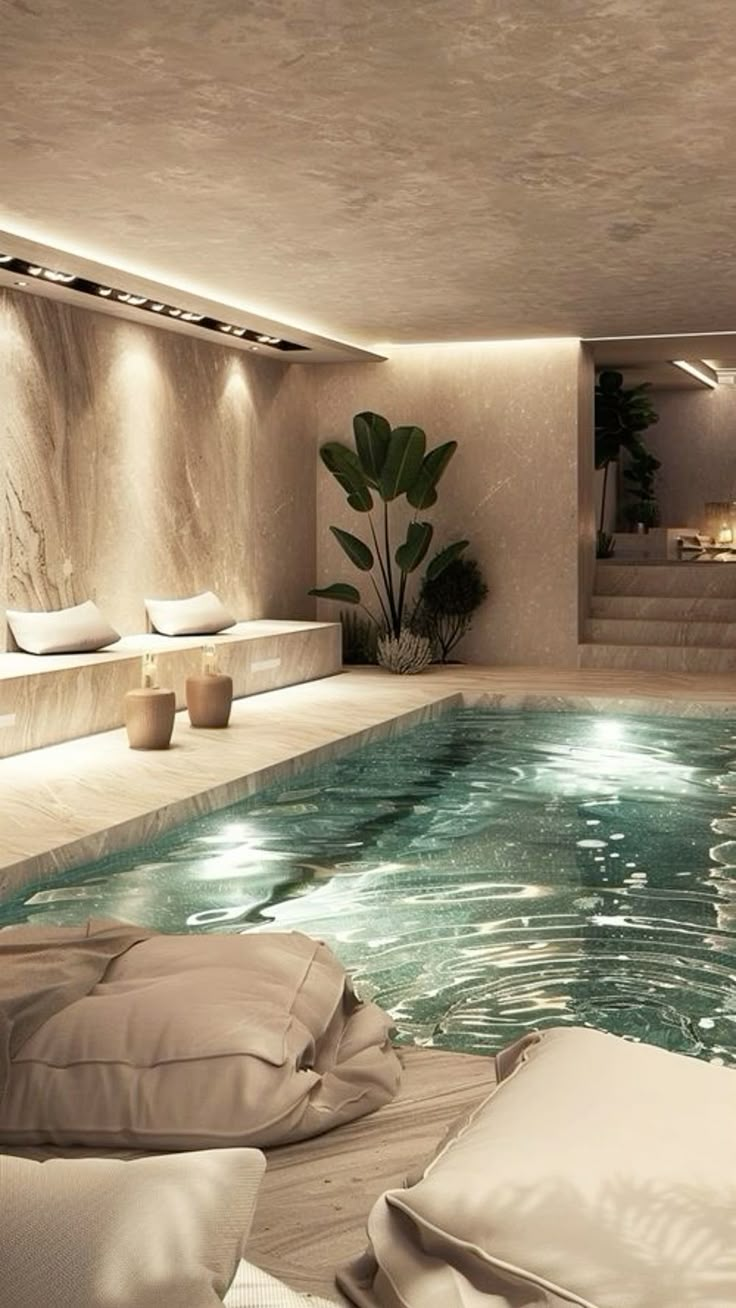
INDOOR POOL
The use of marble in indoor pools offers distinct advantages and considerations compared to outdoor areas.
Advantages of Using Marble in Indoor Pools
1. Aesthetic Appearance
– Marble provides a luxurious and elegant appearance. It creates a prestigious atmosphere, particularly in spaces like spas, hotels, or private villas.
– White, gray, and beige tones make the area appear more spacious and bright.
2. Thermal Insulation and Comfort
– Marble maintains a balanced surface temperature based on the ambient conditions, avoiding excessive heating or cooling in indoor settings.
– It is compatible with underfloor heating systems, providing an advantage, especially in spa-type pools.
3. Humidity and Vapor Resistance
– When properly processed and treated with protective sealants, marble is long-lasting in humid environments.
– Marble types with low water absorption rates should be preferred.
Considerations
1. Non-Slip Property:
– Indoor pool floors are often wet. Therefore, non-slip surface-treated (honed, sandblasted, or brushed) marble should be preferred.
– Glossy and polished marbles increase the risk of slipping in these environments but are suitable for wall applications.
2. Proper Marble Selection:
– Overly porous or soft-structured marbles (e.g., certain travertine types) may be affected by water and chemicals over time.
– Afyon marble, Marmara marble, Burdur beige, and granitic marbles are more durable for indoor pool environments.
3. Chemical Resistance:
– Chemicals like chlorine in pool water can damage the stone structure over time. Therefore, marble must be protected with special water-repellent impregnation products.
4. Maintenance and Cleaning:
– Regular maintenance is required; cleaning products sensitive to acids and abrasives should not be used.
5. Usage Areas:
– Poolside flooring
– Wall cladding (shower areas, pool surroundings)
– Steps and seating areas
– Decorative details (niches, shelves, ornamental pools)
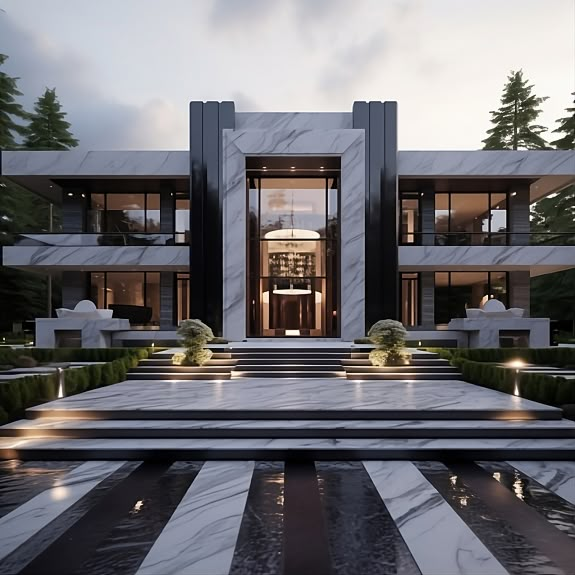
EXTERIOR FACADES
Marble, when used in exterior facades, provides an elegant and luxurious appearance. With its aesthetic appeal, durability, and longevity, it stands out as an ideal material for villa exterior facades.
Benefits and Considerations of Using Marble in Villa Exterior Facades:
1. Aesthetic and Luxurious Appearance
– Elegant Texture and Patterns: Marble, with its refined veining and unique patterns, adds a sophisticated aesthetic to exterior facades. Each marble piece is natural, making every facade distinct and original.
– Rich Color Options: With a wide color palette including white, gray, cream, and black, marble creates a luxurious appearance on villa facades. Its natural tones harmonize with the surroundings, producing a pleasing visual effect..
– Light Reflection: Marble’s glossy surface reflects sunlight, illuminating the building’s facade and providing a vibrant appearance. By reflecting sunlight effectively, it creates perfect harmony with the natural environment.
2. Durability and Longevity
– Weather Resistance: When used in exterior facades, marble is durable and long-lasting, highly resistant to harsh weather conditions, sunlight, rain, and snow.
– Adaptability to Temperature Changes: Marble withstands temperature fluctuations, performing well in both hot and cold climates, offering a lasting solution for villa facades.
– Not Just Visual, but Structural Durability: Marble is as structurally robust as it is aesthetically pleasing. Large marble panels, in particular, provide functional reinforcement to the structure.
3. Easy Maintenance
– Long-Term Cleaning Ease: Marble’s smooth surface simplifies facade cleaning. Dirt and stains on marble can be quickly removed with proper care and cleaning.
– Waterproofing: Marble has low water absorption, preventing rainwater from penetrating the surface and protecting the facade for years. Additional waterproofing treatments can further enhance its durability.
4. Varied Application Methods
– Flat Surfaces and Panel Applications: Marble can be used in large, flat panels. Properly installed marble panels on villa facades achieve a modern and elegant appearance.
– Textured Surfaces: Marble can be textured using various surface treatment techniques. Rough or honed surfaces add a unique texture to the facade, creating visual diversity.
– Continuous Vein Transition (Bookmatch): Bookmatch applications using marble’s natural veining create striking patterns on the facade, imparting a unique style to the villa exterior.
5. Environmental and Aesthetic Harmony
– Doğa ile Uyum: Mermer, doğal bir taş olması nedeniyle çevresiyle uyum sağlar. Özellikle doğal taşlardan yapılmış peyzaj düzenlemeleri ile villa dış cephesi arasındaki geçiş yumuşak olur.
– Doğal Taşların Kombinasyonu: Mermerin, taş veya ahşap gibi diğer doğal malzemelerle birleştirilmesi de mümkündür. Bu kombinasyon, modern ve sıcak bir görünüm elde edilmesini sağlar.
Marble use in villa exterior facades offers significant aesthetic and functional advantages. Its natural beauty and elegance ensure a luxurious and refined appearance for the facade. Durable, long-lasting, and low-maintenance, marble remains a preferred material for exterior designs.
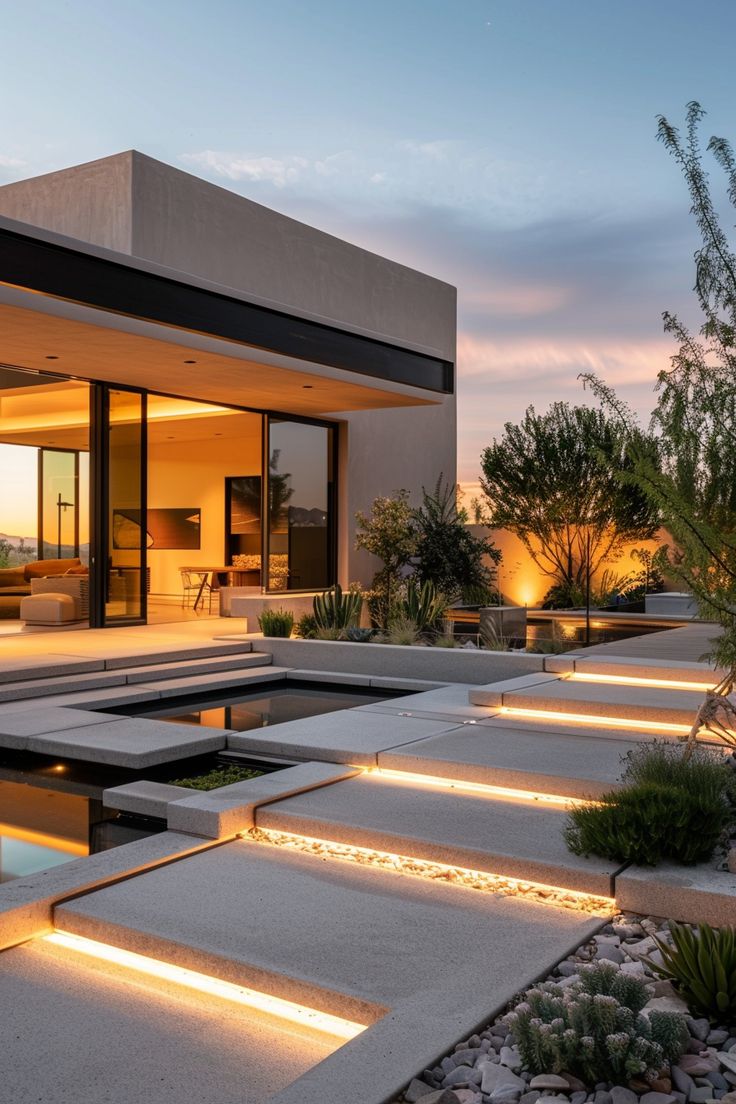
OUTDOOR AND LANDSCAPING
AREAS
In villa outdoor spaces, the use of marble in poolside areas, stepping stones, planters, outdoor bar and barbecue areas, and walkways provides both aesthetic elegance and durability.
Considerations for Using Marble in Outdoor and Landscaping Areas:
1. Marble for Pool Surrounds
-Non-Slip Surface: It is crucial that marbles used around pools have non-slip surfaces (honed or brushed). Polished marbles can be hazardous when wet.
-Heat Resistance: Light-colored marbles do not overheat in sunlight, making them comfortable for barefoot walking.
2. Marble Use in Landscaping
-Walkways and Borders: Cut marble slabs or crushed natural stones can be used decoratively in walkways.
-Decorative Elements: Marble planters, sculptures, fountains, and benches add a classic and luxurious ambiance to gardens.
-Placement: Marble should harmonize with the natural texture. For a design integrated with nature, it is recommended to balance it with green plants and wood.



